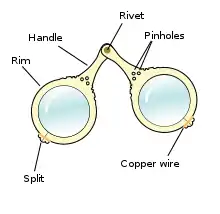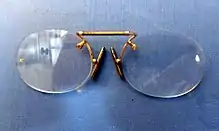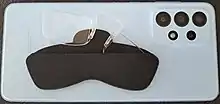Pince-nez
Pince-nez (/ˈpɑːnsneɪ/ or /ˈpɪnsneɪ/, plural form same as singular;[1] French pronunciation: [pɛ̃sˈne]) is a style of glasses, popular in the late 19th and early 20th centuries, that are supported without earpieces, by pinching the bridge of the nose. The name comes from French pincer, "to pinch", and nez, "nose".

Although pince-nez were used in Europe since the late 14th century, modern ones appeared in the 1840s and reached their peak popularity around 1880 to 1900. Because they did not always stay on the nose when placed, and because of the stigma sometimes attached to the constant wearing of eyeglasses, pince-nez were often connected to the wearer's clothing or ear via a suspension chain, cord, or ribbon so that they could be easily removed and not lost.
Varieties
Rivet spectacles

The earliest form of eyewear for which any archaeological record exists comes from the middle of the 15th century. It is a primitive pince-nez whose frames were made from pieces of either metacarpal bone from the forelimb of a bull or from large pieces of antler. The two pieces were each paddle-shaped and were joined by an iron rivet which provided the tension over the nose and allowed the lenses to be folded together. The purpose of the three holes at the place where the handle connects to the hinge is uncertain, though they may have been used for pinhole vision, a principle which was known from ancient times. Each paddle was split at one end to allow for the insertion of a lens, and the split was closed by a piece of copper wire. The frames were extremely light, but the tension in the rivet would have loosened over time making them unable to stay on the nose. Paintings depicting such frames date from as early as 1392 CE. [2]
Subsequent frames were made from cattle horn or from wood, but were consistently designed with a connecting rivet for tension.[2]
C-bridge

These pince-nez possess a C-shaped bridge composed of a curved, flexible piece of metal which provided tension to clip the lenses on the wearer's nose. They were in wide use from the 1820s to the 1940s and were available in a variety of styles – ranging from the early nose-padless type of the 19th century to the gutta-percha variety of the American Civil War era and then on to the plaquette variety of the 20th century. The bridges were subject to constant wear from repeated flexing when being set and removed from the face, so would frequently break or lose their tension. An advantage of this variety was that one size could fit a variety of nose bridges but its inability to manage astigmatism or maintain a fixed pupillary distance meant that it was fundamentally flawed for a large proportion of wearers.
Astig

The "astig"—so called for its ability to manage astigmatism—or "bar-spring" pince-nez consists of a sliding bar and spring connecting the lenses which can be separated by gently pulling the lenses away from each other, then placed on the bridge of the nose and released. The tension in the spring then clips the device in place. The nose pads were traditionally made of cork, were attached directly to the frames, and were either hinged or stationary. This variety was popular from the 1890s to the 1930s, after which they were seldom seen. They were created and marketed as 'sporting pince-nez', which were purportedly more difficult to jar from the face than the other varieties as well as being more comfortable to wear for longer periods. The principal advantage was that unlike the C-bridge pince-nez, whose lenses rotated slightly as they were placed on the nose, the astig's lenses did not rotate and therefore could correct for astigmatism in ways that were impossible with most other varieties of pince-nez—however, they still did not account for pupillary distance.[3]
Fits-U
.jpg.webp)
In 1893 a Frenchman named Jules Cottet developed and patented a finger-piece eyeglass which functioned by connecting the two lenses by a hard, unflexing bridge and clipping onto the bridge of the nose via springs located in the nose-rests. The wearer could pinch onto a pair of levers located above or in front of the bridge to open the planquettes, and release the levers to allow them to close onto the nose of the wearer. Because the lenses did not rotate, these devices could correct for astigmatism, and because they did not move in relation to each other, they could also account for the user's pupillary distance. Cottet registered his patent in France, England, and the United States but did not pursue production and eventually sold the patent to a London-based eyewear manufacturer who in turn sold it to an American firm. The design remained unused for years until it was acquired by American Optical who successfully marketed it under the brand name "Fits-U". In this guise, it quickly replaced most other nose-pinching varieties of eyewear.[3]
Oxford spectacles

The difference between Oxford spectacles (or "Oxfords" for short) and the pince-nez is not frequently drawn. The style was supposedly developed in the 19th century when a professor at Oxford University accidentally broke off the handle from a pair of lorgnette spectacles and reputedly affixed two small nose-pads to the frame and found that he could use the tension in the folding spring to perch them on his nose, though the authenticity of the story has never been verified. Oxfords are descended from the lorgnette, as early examples of them often had handles in addition to nose-pads. In style Oxfords are much like the C-bridge as the tension is provided by a flexible, sprung piece of metal; however, they also resemble the astig, as the spring connecting the two lenses is distinct from the nose-pieces. Oxfords were popular in Europe and the Americas up until the 1930s.
Mobile Phone Glasses

Pince nez are typically smaller and thinner than glasses with arms. This has caused a revival in the popularity of this style of glasses because they can be conveniently attached to the back of a mobile phone. The modern designs use more modern materials, particularly plastics, but still suffers from the disadvantages of a pince nez, including the problem of slipping off the nose described above. Nonetheless, and likely only for occasional use, the benifit of having glasses readily available attached directly to the phone has lead to a wide availability of this style of eye wear. These are usually sold with the case and adhesive tape to attach the case to the phone.
In popular culture
Pince-nez is central to the murder mystery in the Sherlock Holmes story The Adventure of the Golden Pince-Nez. Another murder mystery, Whose Body? by Dorothy L. Sayers, features a victim found dead in a bathtub wearing nothing but a pair of pince-nez.
Numerous fictional characters have been depicted as wearing pince-nez. These include Hercule Poirot in the television series Agatha Christie's Poirot, who wears a pince-nez that is attached to a cord around his neck;[4] Morpheus in the Matrix film trilogy, who wears reflective-lensed pince-nez sunglasses when he appears in the Matrix;[5] Don Knotts title-character in The Incredible Mr. Limpet, who wears them both as a man and a fish; The Walt Disney cartoon character Scrooge McDuck; Professor Frost in the C. S. Lewis novel That Hideous Strength, who is identified multiple times by his wearing a pair of pince-nez; Koroviev/Fagott, a member of Satan's entourage in Mikhail Bulgakov's The Master and Margarita; Roger Swindon in Under Wildwood, the second novel in Colin Meloy's "Wildwood" trilogy; and Dr.Eggman/Robotnik from Sonic the Hedgehog.

In the piece Son binocle from his piano suite Les trois valses distinguées du précieux dégoûté (1914), Erik Satie depicts a jaded dandy cleaning his luxurious pince-nez, which is made from solid gold and smoked glass. Satie himself was a lifelong wearer of pince-nez.[6]
Throughout Arthur Koestler's Darkness at Noon reference is made to the fact that the main character, Rubashov, wears pince-nez and uses them to tap on the pipes in his cell to communicate with fellow prisoners. In Darkness at Noon the pince-nez signifies Rubashov’s belonging to the intelligentsia where a fellow prisoners monocle represents their belonging to the aristocracy.
Gomez Addams (The Addams Family) frequently pulled a pair of pince-nez glasses from his inside left jacket pocket including a reference to the spectacles by Doctor Motley in Season 2, Episode 17, "Fester Goes on a Diet." Popular too on Irish poet William Butler Yeats.
The notorious Spanish poet Francisco de Quevedo was depicted wearing this kind of glasses in his most iconic paintings, like the one by Juan van der Hamen. This image became so peculiar, the style gets called quevedos in Spanish. [7]
See also
- Monocle
References
Notes
- "Pince-nez" Dictionary.com Unabridged (v 1.1). Random House. Accessed: January 10, 2008
- Vincent Ilardi (2007). Renaissance Vision from Spectacles to Telescopes. American Philosophical Society. p. 155. ISBN 978-0-87169-259-7.
- Rosenthal, J. William (1996). Spectacles and Other Vision Aids: A History and Guide to Collecting. Norman Publishing. p. 246. ISBN 978-0-930405-71-7.
- "David Suchet reveals the secret to Poirot's "rapid, mincing" walk". Retrieved 2013-11-13.
- "The End of Humanism". Retrieved 2013-11-13.
- John Keillor. Les valses (3) distinguées du précieux dégoûté (3 distinguished waltzes of a disgusted dandy), for piano at AllMusic
- "Quevedos".